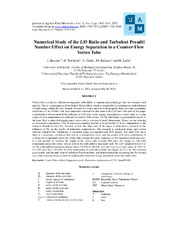Приказ основних података о документу
Numerical Study of the L/D Ratio and Turbulent Prandtl Number Effect on Energy Separation in a Counter-Flow Vortex Tube
| dc.creator | Burazer, Jela M. | |
| dc.creator | Novković, Đorđe | |
| dc.creator | Ćoćić, Aleksandar | |
| dc.creator | Bukurov, M. | |
| dc.creator | Lečić, Milan | |
| dc.date.accessioned | 2022-09-19T19:28:11Z | |
| dc.date.available | 2022-09-19T19:28:11Z | |
| dc.date.issued | 2022 | |
| dc.identifier.issn | 1735-3572 | |
| dc.identifier.uri | https://machinery.mas.bg.ac.rs/handle/123456789/3713 | |
| dc.description.abstract | Vortex tube is a device without moving parts with ability to separate pressurized gas into two streams: cold and hot. This is a consequence of the Eckert-Wiese effect, which is responsible for spontaneous redistribution of total energy within the flow domain. In order for vortex tubes to work properly, there are some constraints which have to be fulfilled. The most important constraint in that sense is the L/D ratio. One part of this paper is dedicated to the research of the influence of L/D ratio on the energy separation in a vortex tube, i.e. to the values of total temperatures on cold and hot outlets of the device. On the other hand, experimental research of the inner flow is quite challenging since vortex tube is a device of small dimensions. Hence, we are relaying on numerical computations. One of important quantities that has to be prescribed in these computations is the turbulent Prandtl number Pr-T. Because of that, the other part of this paper is dedicated to research of the influence of Pr-T on the results of numerical computations. The research is conducted using open-source software OpenFOAM. Turbulence is modelled using two-equation and RST models. For small L/D ratios there is a secondary circulation that acts as a refrigeration cycle, and for greater L/D ratios distribution of velocity and temperature inside the vortex tube remains the same, regardless of the stagnation point presence. It is not justified to increase the length of the vortex tube beyond 20D since the change in cold total temperature inside the vortex tube as well at the cold outlet is practically null. For L/D variation from 1.8 to 10, the cold outlet temperature changes from 270.9 K to 266.8 K, and then rises to its final value of 270.5 K. For L/D ratio from 20 to 60, the total temperature at cold end remains unchanged at 271.3 K. We obtained good results with the unit value of turbulent Prandtl number, and demonstrated that increasing the Pr-T beyond unit value is not necessary in order to numerically obtain the energy separation inside the vortex tube. | en |
| dc.publisher | Isfahan Univ Technology, Isfahan | |
| dc.relation | Science Fund of the Republic of Serbia through project "Research and development of ionic biofluids -RIDIBF" | |
| dc.relation | info:eu-repo/grantAgreement/MESTD/inst-2020/200105/RS// | |
| dc.relation | info:eu-repo/grantAgreement/MESTD/Technological Development (TD or TR)/35046/RS// | |
| dc.rights | openAccess | |
| dc.rights.uri | https://creativecommons.org/licenses/by-nc-nd/4.0/ | |
| dc.source | Journal of Applied Fluid Mechanics | |
| dc.subject | Stagnation point | en |
| dc.subject | Parametric optimization | en |
| dc.subject | OpenFOAM | en |
| dc.subject | Eckert-Wiese effect | en |
| dc.subject | CFD | en |
| dc.title | Numerical Study of the L/D Ratio and Turbulent Prandtl Number Effect on Energy Separation in a Counter-Flow Vortex Tube | en |
| dc.type | article | |
| dc.rights.license | BY-NC-ND | |
| dc.citation.epage | 1511 | |
| dc.citation.issue | 5 | |
| dc.citation.other | 15(5): 1503-1511 | |
| dc.citation.rank | M23~ | |
| dc.citation.spage | 1503 | |
| dc.citation.volume | 15 | |
| dc.identifier.doi | 10.47176/jafm.15.05.1168 | |
| dc.identifier.fulltext | http://machinery.mas.bg.ac.rs/bitstream/id/2262/3710.pdf | |
| dc.identifier.scopus | 2-s2.0-85133761672 | |
| dc.identifier.wos | 000834904900004 | |
| dc.type.version | publishedVersion |


